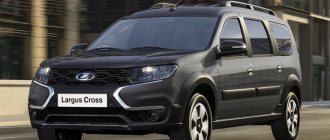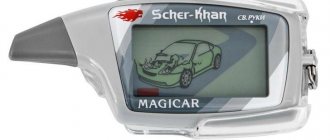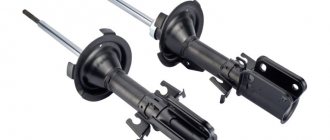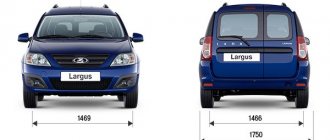LADA Largus is a joint project of AvtoVAZ and the Renault-Nissan Alliance. This car is a high-capacity station wagon and has an optimal price-quality ratio. The interior of the Lada Largus is an almost exact copy of the Renault Logan, with minor changes. For example, the steering wheel has been completely changed. The exterior is also identical to Logan. AvtoVAZ only corrected some details: the front bumper, headlights and radiator grille were changed. As for the chassis of the Lada Largus, it is an exact copy of Logan.
The interior of the Lada Largus is practically no different from the interior of the Renault Logan
Overall, Largus fully lives up to its masculine name and looks like a reliable and trustworthy car. More accurately, you can describe the appearance of the car with words such as rigor, confidence and reliability. This is simply a great family car at an affordable price. It is quite comfortable and roomy. Let's take a closer look at the interior of this vehicle.
Cabin space
Largus is quite spacious inside. The ceilings are high and even if the driver or passengers are tall, they will still be comfortable inside the car. There is a sufficient distance between the rows and even during a long journey there will be no discomfort when sitting and your legs will not become numb. The presence of space is impressive and pleasing.
Consumer reviews indicate that on a long trip, 6 people, including the driver, will feel most comfortable (meaning the seven-seat version). This is due to the fact that in the second row, during a long journey, three passengers will feel somewhat cramped, but two people will be as comfortable as possible.
Dimensions and technical characteristics of the Lada Largus car
The overall dimensions and other data of the Lada Largus car are as follows:
- Seats – 5 or 7 pcs.;
- Length – 4470 mm;
- Width – 1750 mm;
- Height – 1636 mm;
- Front wheel track width – 1469 mm, rear – 1466 mm;
- Curb/gross vehicle weight – 1185/1985 kg;
- Trunk capacity is 535 or 135 liters, increases to 2350 liters;
- Fuel tank – 50 l;
- Ground clearance – 145 mm.
Lada Largus cars are equipped with two modifications of atmospheric gasoline engines with a displacement of 1.6 liters each and with eight or sixteen valves. With any of them, only a manual transmission is available for installation - manual transmission JR5 or JH3/VAZ, each with five gears. Drive type – front.
The first of the engines, the eight-valve K7M/VAZ-11189, provides a power of 84 hp. With. and a maximum speed of 155 km/h, acceleration to 100 km/h is carried out in 14.5 s, and average fuel consumption when driving in the combined cycle is 8.2 liters per 100 km.
The second power unit, K4M, equipped with sixteen valves, produces 105 hp. With. and provides a maximum speed of 165 km/h, and accelerates the car to 100 km/h in 13.1 s. Gasoline consumption with this power unit in the combined cycle is 7.9 liters per 100 km.
The Lada Largus is based on the front-wheel drive B0 platform from the Renault-Nissan alliance of manufacturers, in which classic McPherson struts are installed at the front, and a semi-independent V-shaped beam is used at the rear. In the initial configuration, ABS and power steering are not available to buyers; in other more expensive versions they are installed by default.
Braking systems – drum brakes are installed at the rear, ventilated disc brakes at the front.
Seats
The main component of a comfortable ride in a Largus car is the seats. They are almost identical to Logan's chairs and do not cause any complaints. In addition, the driver’s seat in the “Lux” configuration now has lumbar support adjustment. In addition, the driver's seat has height adjustment. All car seats have adjustable armrests.
There is enough space in the cabin for comfortable trips over long distances
If you compare the first and second rows of seats, they are at different levels (the second is higher). But thanks to the high ceilings, this does not create discomfort.
Exterior of Lada Largus
As already mentioned, the appearance of the Lada Largus is an almost complete copy of Logan with some small touches from AvtoVAZ. The car’s belonging to Tolyatti manufacturers is most clearly visible from the front, by the characteristic emblem on the radiator grille. The headlights look rather modest; the picture is completed by a bumper with smooth outlines and a large air intake mouth.
When viewed from other sides, Lada Largus looks like an ordinary station wagon from any manufacturer. All similar models are characterized by a sloping hood, a flat roof, and side glazing that takes up a large area. At the rear, judging by the photo, you can see two asymmetrical doors, a non-bulky bumper and vertically oriented optics on the sides.
Decoration Materials
In general, the car interior is decorated with high-quality materials. They are not of the highest quality, but are quite consistent with the level and cost of the vehicle. Plastic, of course, leaves much to be desired and many people don’t like its smell. But you can put up with this, and the smell will disappear over time. The upholstery of the chairs is most often two-tone, pleasing to the eye and of quite high quality.
Finishing materials are not the best - but good quality
Foreign analogue
The original model of this car is the French development of Dacia Logan MCP. It is produced at factories in Romania. This is a station wagon car and belongs to the “B” class of cars. Now it is one of the most popular family cars in Western Europe. The appearance and technical characteristics of the Lada Largus are very similar, but there are also significant differences. First of all, this is the radiator grille, which makes the design of the Russian vehicle more stylish and fashionable.
Dacia Logan MCV - one might say, this is the father of our Lada Largus
Luggage compartment
We can say that the spacious trunk is the trump card of the Lada Largus station wagon. In the five-seater version, the luggage compartment volume is 560 liters, in the seven-seater version – 135 liters, and with the seats of the five-seater station wagon folded, it generally reaches 2350 liters. In case of maximum use of the trunk, a mesh can be stretched between the passenger and cargo compartments. For this purpose, there are lugs on the ceiling of the car.
Hinged doors can open either 180 or 90 degrees. In certain cases this makes loading much easier.
Power units
Only two types of power units are installed in the serial Lada Largus. Their volume is the same and according to the passport it is 1.6 liters, but in reality it is 1598 cm3. One of them has a power of 84 hp. s., and for the second modification this parameter is 105 hp. With. The difference arises from the number of valves used. In the first case there are only 8 of them, and in the second version there are 2 times more of them and their number is 16.
Engine Lada Largus
The second version of the power unit is more economical. Its fuel consumption for every 100 km on the highway is 7.5 liters, and in the city – 11.5. In modification with 84 hp. With. these same parameters are 7.7 and 12.5, respectively. Therefore, from this position it is more profitable to purchase a version with 16 valves and 105 liters. With. Although it is more expensive, such a purchase will justify itself in the future due to significant fuel savings.
In all modifications of the Lada Largus, the maximum torque is the same and is quite acceptable 148 Nm at 3750 rpm. Also, the number of cylinders in the engines is the same, regardless of their modification - 4.
The drive type, like most domestic vehicles, is front-wheel drive. 5-speed gearbox, manual. Again, it has been significantly redesigned by domestic engineers and is ideal for our roads. Its gear ratios are very different from those in the original French version.
A high ground clearance of 145 mm will allow this station wagon to definitely feel confident on domestic roads. It is due to this parameter that the car is not afraid of their unevenness, and if the car ends up on such a site, the driver does not strongly feel the unevenness of the road surface. Recommended tire type 185/65R15.
Niches, shelves and pockets
Everything in the LADA Largus is very conveniently arranged to accommodate the little things you need on the road. The mezzanine above the second-row seats is simply perfect for placing things that are not heavy, but sometimes so necessary on the road. The doors are equipped with convenient niches and cup holders. The trunk also has pockets and mesh restraints where you can store tools, a jack, a warning triangle and a cable, as well as other things necessary on the road.
There are quite a variety of niches and shelves in the cabin
Additionally, an armrest-box can be installed between the front seats, inside which you can also transport the necessary little things: glasses, watches, mobile phones, etc.
To summarize, we can say that in the LADA Largus car everything is organized so that both the driver and passengers feel comfortable, comfortable and spacious. To make the interior of the vehicle pleasing to the eye, neutral colors and high-quality materials were used. Numerous niches, shelves and pockets allow you to have everything you might need on the road at hand, especially if it’s a long trip. Air conditioning, heated seats, three-point seat belts and power windows add comfort, convenience and coziness.
Similar articles:
- 7-seater station wagon Lada Largus
- How the Lada Largus presentation was held
- Head unit in Lada Largus
- Review of Lada Largus station wagon in the “Lux” configuration
- The 100,000th Lada Largus was produced
Interior of Lada Largus
The interior of the car, as can be seen from the photo, is practically indistinguishable from the same Logan and is just as ascetic and unremarkable. In the arrangement of instruments and other elements, you can notice the same ergonomic errors that were characteristic of Logan. The set of instruments is laconic, the two-color screen of the course computer and instrument dials are surrounded by chrome trim. The information content of the devices is quite good. The steering wheel is large, mounted on three spokes and has the AvtoVAZ logo in the center.
The number of controls on the central panel is minimal. In the maximum configuration you can find a radio with AUX and USB connectors; in the initial and middle configurations there is a plastic plug instead of a radio. Nearby are the controls for ventilation and heating (air conditioning and stove). Between them there are also buttons for the electric windows of the front windows, the rear door lock, the heated rear window and the hazard warning lights.
All upholstery is made of hard plastic and fabric, and the comfort provided by the seats is minimal. The front seats are quite flat, lateral support is minimal, but the range of adjustment is quite wide. In the luxury version, the driver's seat even has lumbar support and seat height adjustment.
There is also more than enough space for passengers in the second and third rows; the roof does not create an oppressive impression, however, climbing into the third row is not very convenient. However, the car was created to transport goods and passengers on a budget basis. It doesn’t have to be very comfortable, but it copes with its main tasks perfectly well. Despite the cheapness of the interior and upholstery, everything is made quite well and firmly; unnecessary noise or squeaks from poorly secured elements are not annoying, as in other similar cars of this class.
The luggage compartment of Largus deserves special mention. In the version of the car with five passenger seats, its capacity is 560 liters. With the rear seats folded, the compartment capacity increases to 2350 liters, making it possible to transport furniture, refrigerators and other large cargo without any problems. In the passenger version with seating for 7 passengers, the rear row of seats can be easily removed, after which the station wagon will become a truck with the same spacious trunk.
Steering wheel, panel and door cards
The first thing that catches the driver's eye is the new steering wheel. To be precise, it’s not completely new, but exactly the same one could already be found on XRay and Vesta.
But it is worth noting that the steering wheel looks much nicer than the old one, feels good in the hands and, of course, its separate plus is the presence of additional control buttons, which will please many drivers.
The devices are combined in XRay and Vesta style and are represented by three wells, the rims of which are made to look like chrome.
As many people know, most Renault cars for the Russian market are assembled at AvtoVAZ facilities, which is the reason for the great similarity between some VAZ and Renault models.
By the way, the new Largus received updated headlights, which are very reminiscent of the Renault Logan headlights. The dashboard and door cards of the updated version are no exception and are taken from Renault Duster. The panel is made almost identical to the one used in Duster before its latest update.
And the door trim of the new Largus is so similar to the trim from Duster that it suggests that these are most likely the same cards. The glass control unit has also changed, and it is also taken from Duster.
Main disadvantages
Naturally, it’s difficult to talk about the shortcomings objectively, since everyone has different requirements, but it’s worth highlighting the main points that users don’t like the most:
- good sound insulation only in expensive versions;
- The seat heating control unit is inconveniently located;
- it is inconvenient to control the climate system;
- not very convenient control of the multimedia system;
- no front handles on the ceiling;
- The heating of the windshield does not cover the edges (the wipers do not cover them either).
Review of the 7-seater Lada Largus. Immigrant
It’s strange, but many consider Largus a freak, burdened with heavy Zhiguli heredity. They criticize it for its awkward proportions, primitive design, simple materials in the cabin... And they study the car with practical interest: the possibilities of interior transformation, the engine under the hood. The result is that there are more and more Largus cars on the road, but you still have to try to buy a car.
Lada Largus is nothing more than a Renault Logan MCV station wagon, or more precisely a Dacia Logan MCV, which has been produced in Romania since 2006. In Russia, they have also been waiting for the car since about the same time - immediately after the launch of production of the Renault Logan sedan in Moscow. But, alas, even when AvtoVAZ officially became part of the Renault-Nissan alliance in 2008, the assembly of the universal Logan in Togliatti did not begin: first there were long processes of acquiring a license for the B0 platform from the French, then the car was finalized by AvtoVAZ specialists. Reconstruction and debugging of the first line of the conveyor led to the fact that Largus production began only in 2012, when the original model in Romania was preparing to be discontinued. Finally, the Lada Largus began to be mass-produced and became available for free sale at AvtoVAZ dealers. True, the concept of “free sale” is conditional, since the queues that have accumulated since last summer still remain, and cars in the “Lux” configuration are promised only by the end of spring. That is why our test was not carried out by the top version with a 16-valve engine, but by its more modest version in the “Norma” configuration, equipped with an 8-valve power unit. But “our” car is a seven-seater, which means that we will still see all the advantages of Largus and its main differences from Logan!
The front part of the Largus differs slightly from the Logan: a different radiator grille, a slightly changed bumper and hood, and... Yes, perhaps that’s where the differences end
The wheelbase of Largus is very stretched, which is why in profile the car does not look entirely harmonious and balanced
After an overnight stay, snow accumulates under the door frames extending onto the roof, which falls into the cabin when the door is opened. Cleaning it with a brush is an almost useless task.
There is room to attach the gas tank cap during refueling, but there are no locking mechanisms
On the windshield there are markings of the Bor Glass Factory. And in general, the degree of localization of Largus was initially 50 percent, and today it is even more
The towing eye in the rear bumper is not covered by anything, but its location in the recess of the plastic imposes restrictions on the size of the hooks and loops of the towing cable
Logan's Legacy
I open the driver's door (the lock, by the way, works with a pleasant dull clatter) and sit down in the driver's seat... I recognize you, old Logan: Largus has a similar driver's seat, devoid of distinct lateral support, and in general some kind of incomprehensible average rigidity - it seems not Zhiguli is already, but on a long journey it will not be easy. And the ergonomic strange... that is, the features have not gone away: after you adjust the seat according to the accessibility of the pedals, the steering wheel turns out to be too close to the driver, and for the correct landing you have to tilt the seat back more than desired - fortunately, there are thumbwheels for adjustment moved from left to right, into the space between the seats, where they are at least convenient to use. But the button for turning on the heating remained in an inconvenient and blind zone between the airbag and the door, where not every driver can fit his hand (not to mention turning on the heating on the go). The situation is partly saved, but don’t be surprised by the automatic operation of the heater! But it is not perfect either: the system, which works on the “on-off” principle, cannot correctly monitor the heating level, and therefore the fifth point from time to time warms up more than desired.
The front panel is almost identical to Logan's, with the exception of the lining on the center console, the instrument panel visor and the upper part opposite the front passenger. But the plastic from which all this is made seemed more pleasant than on Logan: on top it, albeit just a little, still lends itself to pressing with your fingers, in some places there is even a hint of “rubberized”, and the ventilation deflectors were generally amazing with its tight fit without a hint of play... Is this a Lada? Judging by the emblem on the steering wheel, it's a Lada. But the smell of a new car is not at all Zhiguli, or even Logan’s - the plastic here is actually different...
The Largus Logan dashboard on the “Norma” version is simplified: there is no on-board computer where you can view data on fuel consumption, average speed or power reserve. But the dark instrument dials are definitely better than the white ones on the top versions of Logan. Another thing would be to make the risks on intermediate readings not so large, and divide the direction indicators into right and left, and replace the stupid relay buzzer with a normal clicking sound...
In general, the front panel is borrowed from Logan: visual differences are only in the shape of the top trim and the design of the center console
It’s unusual to see a VAZ rook on a Logan steering wheel, but the steering wheel itself does not cause rejection: it is pleasant to the touch even without a “leather” braid
Despite the similarity of the interior with Logan's, other finishing materials are used here, which, in our opinion, are better on the Lada: here the plastic in the upper part of the panel is more pliable, and the design is generally more pleasant (especially on the richer “Lux” variants).
The horn button, traditionally for French cars, is located at the end of the left steering column lever. But Lada is not a French brand, and to give a signal, out of habit, you hit the steering wheel hub...
The seat heating button is located on the side of the cushion and becomes very difficult to use when the door is closed. The only thing that saves is the semblance of an automatic heating mode, in which it automatically turns off (and turns back on!) the heating when a certain temperature is reached
The standard radio does not have a label (in fact, it is a Korean Daewoo), but it does offer a USB port and a mobile phone connection via Bluetooth with the ability to make calls and talk without taking your hands off the wheel
If there is a front passenger airbag, it is also possible to turn it off (to be able to install a child seat forward, for example)
The glove compartment is not too voluminous, but its width and depth allow you to put A4 paper there, and the lid has an additional compartment for storing instructions and a service book
Calm, just calm
The steering wheel left a pleasant impression: there are no burrs, and it doesn’t feel “cold” to the touch: after parking for the night, I didn’t feel the need for gloves. But the effort on it seemed too great: even in winter, on snow, not everyone will be able to turn the steering wheel with one hand in a parking lot, and active maneuvers will not be easy. This is especially noticeable against the backdrop of the ultra-light clutch and accelerator pedals, which, due to this “airiness,” are devoid of information content. However, Largus was not created for sporty driving: its suspension is unable to provide sufficiently high grip and stability in corners, the body rolls noticeably and involuntarily forces you to slow down. However, thanks to the extended wheelbase, Largus is absolutely devoid of any tendency to skid in corners (even with the handbrake, this station wagon is not very willing to slide). And on a straight line, the car is surprisingly stable, not particularly reacting to gusts of side winds, or to road imperfections in the form of asphalt joints and potholes falling under the wheels. Largus is generally insensitive to the condition of the road surface - thanks to the same Logan suspension, in which the front arms were made more powerful (as on the Logan MCV cargo vans). But the energy intensity remained the same, thanks to which Largus can be driven at speed where crossovers and even many purebred SUVs slow down! Thanks to the long wheelbase, passengers do not feel any bumping when driving over asphalt waves or gently sloping speed bumps. But the empty car shakes noticeably: there is clearly a reserve of carrying capacity for seven passengers. True, the nameplate carrying capacity is only 480 kg. Have the VAZ people been modest?
The maximum speed also seemed underestimated: the Largus accelerated to the rated 155 km/h, although not effortlessly (the car needed at least two kilometers of highway for this), but not with all its might. The small reserve of power and capabilities of the generally modest 8-valve engine was still felt in fifth gear. But there can be no talk of any safe overtaking on the highway, especially with a full load: Largus accelerates from a standstill with emphatic restraint and without enthusiasm. At the same time, it is better to check the fastening of the mats borrowed from Logan: during our test, the driver’s rubber trough, not being secured after washing with standard pins, moved only a centimeter forward and began to catch the gas pedal pressed to the floor - just like the “problem” Lexuses in America. Some agility is still evident in the city when accelerating from a standstill - thanks to the closely spaced gears in the box. But even here, after the permitted 60 km/h, Largus begins to noticeably inferior to its downstream neighbors, becoming more like GAZelles than its platform brothers such as Logan, Sandero and even Duster with similar engines. Some will say that such dynamics are forgivable for a family-country station wagon. But I can give a counter argument in the form of the need to make a quick (and, therefore, safe) overtaking - here Largus, alas, does not correspond to modern driving conditions. Now, if only the Largus could be ordered with a 2-liter engine from Duster, or at least its own diesel engine, which, although it won’t add agility, will give you heavy-duty power when fully loaded... Unfortunately, such options are not expected.
But an automatic transmission may be a reality in Largus. Yes, with it the car will become even more phlegmatic. But on the other hand, there will be no mismatch in the force on the steering wheel and pedals, and a long lever with short strokes will no longer bother you with riddles about whether you will get into the right gear or not. And the clarity of engagement is also not ideal: from time to time I was unable to push the lever all the way when engaging reverse gear (which, by the way, is not protected by any locks against accidental engagement on the move).
And only the Largus brakes had no complaints: the force is exactly the same as required to confidently stop a long and roomy station wagon. And the anti-lock braking system works delicately, without frightening the driver who is accustomed to Zhiguli with its presence.
Getting Largus into a skid even with the handbrake is not very easy: the long wheelbase gives the car good directional stability while driving, and at the same time also noticeable understeer
Studying the instructions for a new car will allow you to learn a lot of new and interesting things: in particular, it turns out that speed is an expensive pleasure, and driving through puddles is allowed only if the water level does not exceed the lower edge of the rim
The front suspension has reinforced arms, but in general it is the same as on Logan
Unlike Logan, the rear suspension of Largus has stiffer springs and shock absorbers
The engine compartment is exactly the same as Logan's, only without the Renault emblem on the decorative engine cover. And the 8-valve Renault K7M engine discovered an unexpected advantage in operation over the 16-valve K4M: the filling volume of engine oil here according to the passport is only 3.3 liters, while the more powerful version will require 1.5 liters more when changing the oil - 4 .8 liters!
The battery on Largus is powerful: its capacity is 70 Ah, and the starting current is 720 A according to the EN method
Let's all sit down!
And yet, the main advantage of Largus is not its all-consuming suspension, but its seven-seater interior. Tell me, what's wrong with that? I answer: it pleasantly surprises with the spaciousness inside and the amount of space for all seven passengers. In fact, I don’t know of any other seven-seat station wagon or compact van (up to 4.5 meters long) that could accommodate the third row with such comfort. And if there is not too much space above the heads of the “gallery” passengers (this is due to the placement of the seats on the principle of an amphitheater, where each subsequent row is located ten centimeters higher than the previous one), then in terms of width two adults fit quite freely. Enough room for knees and even feet up to shoe size 45. By and large, the only thing you can complain about here is the rise of the floor in the heel area, which is why the feet rest with an uncomfortable downward tilt.
The middle row is also quite comfortable due to the high position of the sofa above the floor level. But tall passengers in the front can noticeably reduce knee room, and the seat belt for the middle passenger must be pulled out from under the ceiling almost at the very luggage doors (and it also creates discomfort for those sitting in the back). Unfortunately, it is impossible to integrate it into the back of an average sofa due to the insufficient rigidity of the back itself.
About the seats in the front: here they are moderately comfortable and without obvious discomfort - like in Logan.
The trunk capacity directly depends on the number of people sitting in the cabin: the more passengers, the less luggage. In the seven-seat configuration, even a couple of supermarket bags won't fit behind the backrests of the third row. But folding the third row of seats does not solve all the problems with luggage placement: there are rigging rings in the floor for securing cargo, but there are no hooks for securing bags and packages. How will everything start to “fly” in a large trunk?
Another feature of the transformation of the Largus trunk is the need to dismantle the very rear row when using the trunk to the maximum. And fortunately, this is not difficult to do: just snap off two levers in the hinges. But removing a massive and heavy “bench” alone will not be easy, and this must be done in advance and preferably in the garage, because there is absolutely nowhere to hide the removed sofa in the car. The placement of the spare wheel under the trunk floor also seems controversial: yes, when replacing a wheel you won’t have to remove your luggage. However, on our roads, the spare wheel will quickly become covered with a layer of dirt, and it is inconvenient to attach a punctured wheel to an underground bracket (especially if there is still dirt on the street). But I liked the swing doors of the trunk doors, which open 90 degrees by default, but can also be opened “swing”, without any problems. In addition, such doors provided Largus with a low loading height of the trunk - loading heavy things will not cause difficulties. I wish the jumper between the rear windows did not interfere with the view into the interior mirror. However, the headrests of the two rear rows of seats interfere with visibility even more, and the center passenger's seat belt, stretched across half the cabin, also, albeit slightly, limits visibility. And in the exterior mirrors, especially the right one, you can see, unfortunately, less than necessary. But such is the price for capacity.
The upholstery of the rear doors is unsightly, but the only inconvenience, by and large, is the lack of a normal internal handle that you could hold on to while the car is moving.
A simple lock for the middle row seatbacks works easily and effectively, allowing you to fold the seat in one and a half movements to access the gallery
Slightly opening vents of the “luggage” windows are the prerogative of exclusively seven-seat versions of Largus
Both tailgate doors can be opened 180 degrees, but the trunk volume in the seven-seat cabin configuration is small - only 135 liters
The rear window wiper is placed only on the left (larger) tailgate flap
The reverse section is only in the right rear light, while in the left there is a rear fog light in its place
The hinged design of the trunk doors made it possible to place an additional pocket for small luggage in one of them. But there is no finishing of window openings here
The tailgate lock, which limits their opening to only 90 degrees, can be easily unlocked using an additional button on the doors
To get the maximum amount of cargo space in the seven-seater Largus, it is not enough to fold the rear seats - the gallery will also have to be dismantled, since it gets in the way even when folded
The maximum volume of cargo space is just under 2.5 cubic meters, achieved after folding the second row seats and removing the third row seats
The spare tire hangs under the trunk floor and is exposed to all winds and dirt.
Don't skimp on Largus!
One of the meanings of the Latin word Largus is generous. But this definition doesn’t fit well with a purely budget station wagon. But generosity is still needed when buying a Largus - on the part of the buyer when choosing a configuration, so as not to subsequently regret saving on their own comfort and convenience. The Largus “Norma” version that was tested in our test does not have many of the nice options available in the richer (but also more expensive!) “Lux” versions. And if the presence of an on-board computer, rear power windows, decorative inserts on the front panel console or painting of exterior mirrors and door handles in body color can be neglected, and the funny squeaky signal of a single-tone horn can be independently replaced with horns “from the Volga”, then the height adjustment of the driver’s seat and, especially, lumbar support will help many people maintain back health. It is more convenient to fold the back of the third row sofa separately, rather than entirely (when a third arm is clearly missing). And electrically adjustable exterior mirrors are much more convenient than the antediluvian “joysticks” in the corners of the front doors (especially on the right mirror, which you can’t easily reach from the driver’s seat).
Yes, and other options, available, including on the “Norma” versions, will not be superfluous: a luggage rack under the ceiling will significantly facilitate the placement of small items in the cabin, fog lights will make it easier to drive in difficult weather conditions, the Largus audio system already has not only USB input, but also allows you to connect a mobile phone via Bluetooth and talk with your interlocutor without taking your hands off the steering wheel (the function actually works, but requires you to speak towards the interior mirror, in front of which there is a microphone in the ceiling). In general, the budget is a budget, but there is no point in denying yourself small joys. Moreover, the final surcharge for all this is not so great: the difference between the minimum and maximum cost of seven-seat versions of Largus is 54,800 rubles. But this amount, among other things, also includes a more powerful and high-torque 16-valve engine, with which the Largus is much more pleasant and dynamic on the go. And all this for less than half a million rubles! Is Largus worth the money?
For Lada this is a considerable price. But... Largus, by and large, has no competitors! The few seven-seater compact vans that we offer cost almost twice as much, even as standard. And the only five-seater station wagon for similar money to the Largus is (don’t be surprised) VAZ’s Lada Priora, with a less spacious interior, smaller dimensions and, in general, a much more archaic design. Yes, the Priora is a Logan, and in similar trim levels to the Largus it is a little more expensive (but it is shorter, exclusively five-seater and with a non-transformable interior)! So it’s not without reason that there are queues of buyers lining up behind Largus. All that remains is to find out how reliable it is: did the curse of the assembly site spread to it, or did the French manage to remove this spell?
Technical characteristics of Lada Largus
| Body | |
| Type | Station wagon |
| Design | Carrier |
| Number of seats/doors | 7/5 |
| Engine | |
| Type | Gasoline with direct fuel injection |
| Engine location | Front transverse |
| Quantity and location cylinders | 4, in-line |
| Working volume, cubic meters cm | 1598 |
| Compression ratio | 14,0:1 |
| Number of valves per cylinder | 2 |
| Power, l. With. at rpm | 84/5000 |
| Torque, Nm at rpm | 124/3000 |
| Transmission | |
| Drive unit | Front |
| Transmission | 5-speed mechanical |
| Steering | |
| Type | rack and pinion, with hydraulic booster |
| Turning diameter | 11.25 m |
| Suspension | |
| Front | Independent (McPherson), spring |
| Rear | Semi-dependent (elastic beam), spring |
| Wheels | |
| Discs | Steel wheels |
| Tires | 185/65 R15 |
| Dimensions, volume, weight | |
| Length/width/height, mm | 4470/1750/1636 (1670 with roof rails) |
| Wheelbase, mm | 2905 |
| Ground clearance, mm | 160 |
| Track front/rear, mm | 1469/1466 |
| Curb weight, kg | 1330 |
| Total weight, kg | 1810 |
| Fuel tank volume, l | 50 |
| Trunk volume, l | 135 (7 seats), 560 (5 seats), 2350 (max.) |
| Dynamic characteristics | |
| Maximum speed, km/h | 155 |
| Acceleration to 100 km/h, sec. | 14,5 |
| Fuel consumption, l/100 km: | |
| Mixed mode | 9,5 |
| Fuel type | 95 octane gasoline |
What is the price?
Largus is rightfully considered one of the most affordable station wagons on our market: in a five-seater version, prices for it start at 360 thousand rubles - only Lada Kalina station wagons are cheaper, the cost of which is from 312 to 426 thousand rubles. At the same time, even in the simplest “Standard” configuration with an 8-valve engine (84 hp), Largus will have a driver’s airbag, rear seat headrests, headlight range control, immobilizer, height-adjustable steering wheel, audio preparation (wiring and antenna) and the ability to get a metallic color.
The most affordable seven-seater Largus is offered in the more expensive “Norma” configuration and is estimated at a minimum of 408 thousand rubles. But here, in addition, there are ABS, a separate middle sofa, power steering, electric windows in the front, central locking (though without remote control) and such little things as a mirror in the passenger sun visor, height adjustment of the front seat belts, athermal glass painted in body color bumpers and protective door moldings. More expensive “Norma” versions may have a passenger airbag (with the ability to turn it off), fog lights, a luggage rack under the roof of the cabin, a trunk curtain, heated front seats, air conditioning, an audio system with CD/MP3/USB/Bluetooth, roof rails and alloy wheels. The cost of such Largus can reach 449 thousand rubles.
The “Lux” version starts from 430.3 thousand rubles. and in addition to a more powerful (105 hp) 16-valve engine, it includes a two-tone sound signal, an on-board computer with an information display in the instrument cluster, a separate backrest for the third row seats, a richer interior trim with decorative inserts on the front panel and instruments, a cigarette lighter and a portable ashtray, as well as a driver's seat with height adjustment and lumbar support. More expensive versions allow you to get central locking with remote control from the key, power windows for the rear doors, electric drive and heated exterior mirrors (painted in body color) and protective coating on the door sills. The maximum cost of such Largus is 462.8 thousand rubles.
In addition, Largus is also offered in a utilitarian cargo “van” version, with blank sides of the cabin and a spacious cargo compartment up to the very front seats. And these vehicles can also be recognized as one of the most affordable delivery vans in Russia: the cost of the simplest van is only 330 thousand rubles, and for a van filled with the most options they ask for 383 thousand. The engine is only 8-valve.










